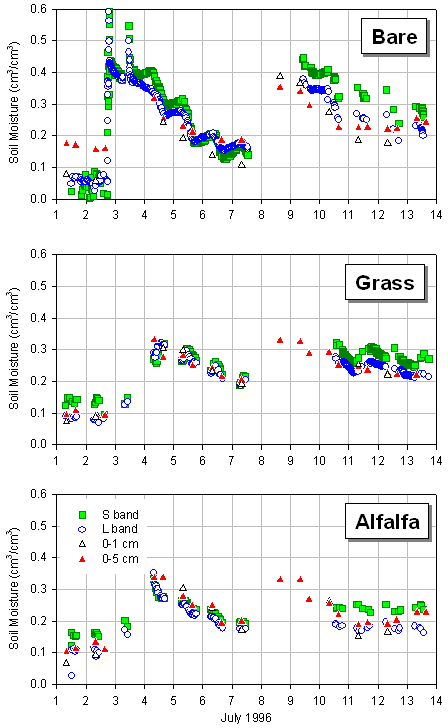




Experiments in Ground-based Microwave Remote Sensing of Soil Moisture
Recent advances in microwave remote sensing technology indicate that surface soil moisture can be inferred with both ground-based and aircraft-based remote sensing systems operating in the microwave region of the electromagnetic spectrum. Experiments conducted over the past two decades have resulted in a basic operational approach whereby microwave brightness temperature (TB) is related to soil moisture. This technique can be applied successfully if other factors known to affect TB, such as instrument configuration and target characteristics (i.e., soil texture and temperature, surface roughness, and vegetation), are invariant for a particular locality. To contribute to this research, an experiment was conducted near Huntsville, Alabama in 1996 and again in 1998. The overall objective of these plot-scale studies was to test and refine algorithms used to estimate surface soil moisture using microwave remote sensing.
 |
| The active and passive microwave remote sensing systems used in the field experiments. |
Three microwave radiometers and a multi-frequency radar were used in
these experiments. The S (2.65 GHz) and L (1.413 GHz) band Microwave Radiometer
(SLMR) is a dual-frequency passive sensor system. In addition, a six channel
stepped-frequency (4.63, 5.06, 5.91, 6.34, 6.77, 7.20 GHz), single polarization
C band radiometer was used. The radiometers were deployed from a single
boom truck along with ancillary sensors. A multifrequency radar system,
operated by NASA Goddard Space Flight Center and George Washington University,
includes a L (1.6 GHz), C (4.75 GHz), and X band (10.0 GHz) radar capable
of like- and cross-polarization.
 |
| Close-up of the passive microwave radiometers and ancillary instruments. |
Automated soil profile and radiation measurement systems were installed on each plot to provide continuous measurements of soil moisture and temperature profiles and other hydrologic variables. A separate stand supported a double-sided pyranometer and a total hemispherical radiometer. Together these instruments provided all four components of the surface radiation balance. Additional meteorological measurements were made at selected locations within the experimental area.
Differences in the moisture content among plots were observed. The microwave remote sensing data collected during this experiment lend themselves to an evaluation of the radiometer and radar performance in a) capturing the time series of moisture change through two wetting and drying cycles, b) recording the diurnal cycle of moisture change, c) comparing microwave wavelengths in a and b, and d) comparing a-c as a function of different vegetation cover.
 |
| Time-series of remotely sensed soil moisture over a bare plot and ones covered with grass and alfalfa. Validation measurements for the 0-1 and 0-5 cm soil layer are shown as triangles. |
The remote sensing instruments were able to detect both the large surface moisture changes due to rainfall and subsequent drying as well as the diurnal fluctuations in moisture. Subsequent research has concentrated on converting the TB and backscatter data to estimates of actual moisture content by refining and analyzing the sensitivity of several algorithms. These data are being used to define the soil depth emitting and reflecting energy at various microwave wavelengths, study single-scattering reflectivity to improve vegetation models, and exploit the strengths of passive and active systems in an integrated solution to soil moisture estimation. We are also using these data to test concepts for developing a method for assimilating remotely-sensed soil moisture information in hydrologic models to improve their performance.
This research is conducted in collaboration with the Center for Hydrology, Soil Climatology, and Remote Sensing at Alabama A&M University. Collaboration with other investigators is being encouraged.
For further information:
Laymon, C.A., Belisle, W., Coleman, T., Crosson, W., Fahsi, A., Jackson,
T., Manu, A., O'Neill, P., Senwo, Z., and Tsegaye, T., 1999, Huntsville
'96: An experiment in ground-based microwave remote sensing of soil moisture,
International Journal of Remote Sensing, v. 20, no.4, 823-828.
Responsible Official: Dr. James E. Arnold (jim.arnold@msfc.nasa.gov)
Technical Contact: Charles Laymon (charles.laymon@msfc.nasa.gov)
Page Curator: Diane Samuelson (diane.samuelson@msfc.nasa.gov)
Last Updated: December 30, 1999